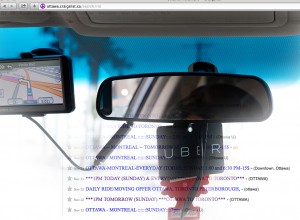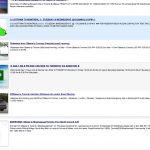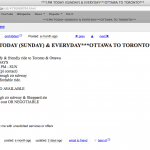By Evelyn Harford

(Photo © Joakim Formo at Flickr Creative Commons.
Modified by Evelyn Harford)
Ride-sharing is a cheap transport alternative in a legal grey-zone.
Uber has come under-siege recently by the City of Ottawa, which calls it an illegal ride-sharing company. However, the City of Ottawa continues to promote carpooling among its residents. The line drawn between illegal and legal ride-shares remains blurry.
Ride-sharing is a transaction between a driver and passenger to share a ride from point a to point b.
Ottawans, like Algonquin College student Adrian Sterling, flock to the web in search of cheap ride-sharing options. Sterling frequently uses Kijiji to find cheap rides when he travels to Toronto or Waterloo.
“If I was to go every week for a month, I would save about $100 dollars,” said Sterling. “I use ride-shares because they’re more efficient, I find I get there quicker, there’s not as many stops.”
Sterling said that he usually likes to hitch a ride with the same ride-share driver each time he travels. With different drivers offering a variety of destinations and prices, it is always easy to find a ride.
“There are other students. It’s a good experience,” he said. “At first I was skeptical about it. When you think of ride-shares you automatically think it’s you and the driver, and maybe one other person. It could be dangerous or something, but it’s always been a good experience, there could be two guys and three girls, we’ll play games on the way down and crack jokes.”
Proponents of ride-share say the trend is growing. There were 51 ride-share Kijiji ads posted today alone. Others use Craigslist and social media platforms like Facebook and Tumblr to both find and advertise ride-shares.
When it comes to enforcement, the Ottawa police say it’s a bylaw issue and it’s up to the city to figure out which rules the cops should enforce and how. In the midst of all this, the City of Ottawa says it is currently reviewing its taxi bylaw.
Montrealer Jonathan Haines uses Facebook, Craigslist, Kijiji and university boards to advertise his ride-sharing services. Haines has been offering rides to strangers and friends in his 2010 Hyundai Accent Hatchback for seven years, though he said he did not buy his hatchback with ride-sharing in mind.
“I recognized that I am providing a service that legally speaking would be regulated,” Haines said. “So I am operating outside the law, but I am not operating a business. I do one ride a month. The people that are operating the vans are operating unregulated businesses.”
If the City is going to crack down, Haines said it should focus on the vans operating daily between large cities.
“I think what they could curtail more, is the ride-share services that go everyday in vans. They are more of a problem. This is their whole income, and they would be avoiding taxes,” Haines said.
The cost of trips from Ottawa to Toronto and Montreal range from $15 to $40. But, as with everything on Craigslist or Kijiji there is room to bargain.
While the City of Ottawa promotes carpooling, it remains unclear about what constitutes a ‘legal carpool’ and what is defined as an illegal ride-share.
What is clear, according to insurance providers like All-State and RBC, drivers should have insurance covering the liability involved in a carpooling or ride-sharing arraignment. RBC Insurance recommends drivers check their insurance policy if they are participating in a ride-share or carpool.
In some cases when car owners indicate they take regular carpool passengers, their premiums go up to cover the cost of accidents that could leave passengers injured.
For now, ride-sharers not affiliated with larger companies like Uber enjoy relative freedom to offer their low-cost ‘service’.
Megabus uses a ride-share model to offer discounted rates to its passengers. Megabus, operating under bus company Coach Canada, offers trips between Toronto and Montreal at a much cheaper rate than Greyhound. However, Megabus does not run routes from Ottawa to Toronto or Ottawa to Montreal – routes that see the heaviest traffic from small-time rider-sharers advertising on Craigslist and Kijiji.
Coach Canada President John Emberson said the Ontario Highway Transportation Board rejected the application for Coach Canada to extend service between Ottawa and Toronto in the summer 2014.
“The province doesn’t want to over serve the routes,” said Emberson.
But, the number of ride shares advertised from Ottawa to Toronto and Montreal suggest there is a lot of demand for cheaper rides.
Emberson said that at Megabus, “We do our own version of ride-share. With the other carriers you’re just buying a ticket. In our case, for Megabus, you’re reserving a seat on a bus and we try to price that bus to get the seats full and by doing that we’re able to pass on the discounted savings to the passengers getting on the bus.”
Emberson said Coach Canada will continue trying to break into the Ottawa to Toronto, and Ottawa to Montreal routes. Until then, cheaper options will live and breathe on Craigslist, Kijiji and Facebook – supporting a largely underground mini-economy.







